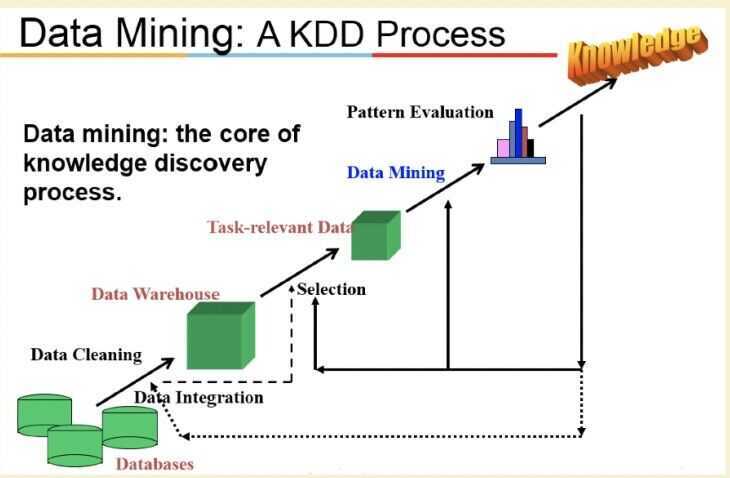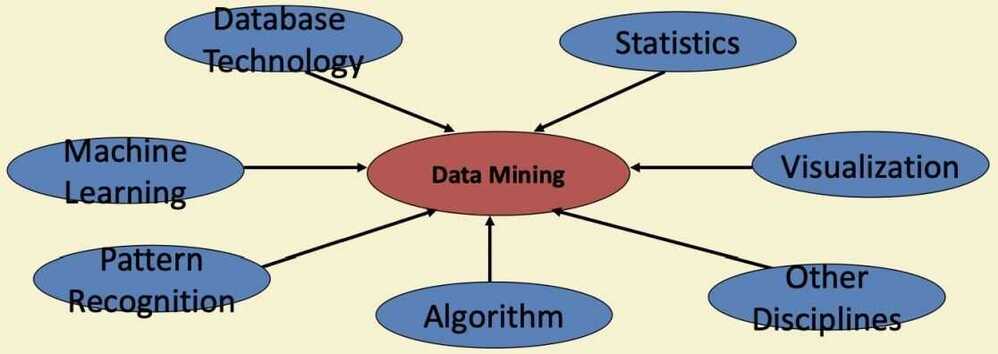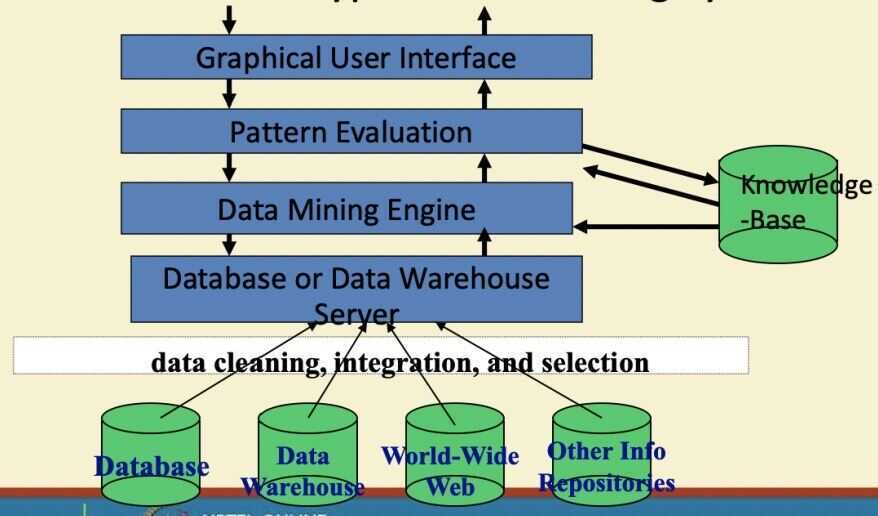Data Mining
Why data Mining
- The explosive growth of data: from terabytes to petabytes
- Data collection and data availability
- Automated data collection tools, database systems, Web, computerized society
- Major sources of abundant data
- Business: Web, e-commerce, transactions, stocks
- Science: Remate sensing, bioinformatics, scientific simulation
- Society and everyone: news, digital cameras, YouTube
- Data collection and data availability
- We are drowning in data, but starving for knowledge
- "Necessity is the mother of investion" -- Data mining -- Automated analysis of massive data
What is Data Mining
- Data mining (knowledge discovery from data)
- Extraction of interesting (non-trivial, implicit, previously unknown and potentially useful) patterns of knowledge from huge amount of data
- Alternative nams
- Knowledge discovery (mining) in databases (KDD), knowledge extraction, data/pattern analysis, data archeology, data dredging, information harvesting, business intelligence

Data Mining: Confluence of Multiple Disciplines

Why not traditional data analysis?
- Tremendous amount of data
- Algorithms must be highly scalable to handle such terabytes of data
- High-dimensionality of data
- Micro-array may have tens of thousands of dimensions
- High complexity of data
- Data streams and sensor data
- Time-series data, temporal data, sequence data
- Structure data, graphs, social networks and multi-linked data
- Heterogeneous dtabases and legacy databases
- Spatial, spatiotemporal, multimedia, text and web data
Data Mining: On what kinds of data?
- Database-oriented data sets and applications
- Relational database, data warehouse, transactional database
- Advanced data sets and advanced applications
- Data streams and sensor data
- Time-series data, temporal data, sequence data (incl. bio-sequences)
- Structure data, graphs, social networks and multi-linked data
- Object-relational databases
- Heterogeneous databases and legacy databases
- Spatial data and spatiotemporal data
- Multimedia database
- Text databases
- The world-wide web
Data Mining Functionalities
- Multidimensional concept description: Characterization and discrimination
- Generalize, summarize, and contrast data characteristics e.g. dry vs wet regions
- Frequent patterns, association, correlation vs causality
- Tea -> Sugar [0.5%, 75%] (Correlation or causality?)
- Classification and prediction
- Contruct models (functions) that describe and distinguish classes or concepts for future prediction
- Eg. Classify countries based on (climate), or classify cars based on (gas mileage)
- Predict some unknown or missing numerical values
- Contruct models (functions) that describe and distinguish classes or concepts for future prediction
- Cluster analysis
- Class label is unknown: Group data to form new classes, e.g., cluster houses to find distribution patterns
- Maximizing intra-class similarity & minimizing interclass similarity
- Outlier analysis
- Outlier: Data object that does not comply with the general behavior of the data
- Noise or exception? Useful in fraud detection, rare events analysis
- Trend and evolution analysis
- Trend and deviation: e.g. regression analysis
- Sequential pattern mining: e.g., digital camera -> large SD memory
- Periodicity analysis
- Similarity-based analysis
- Other pattern-directed or statistical analysis
Major Issues in Data Mining
- Mining methodology
- Mining different kinds of knowledge from diverse data types, e.g., bio, stream, web
- Performance: efficiency, effectiveness, and scalability
- Pattern evaluation: the interestingness problem
- Incorporation of background knowledge
- Handling noise and incomplete data
- Parallel, distributed and incremental mining methods
- Integration of the discovered knowledge with existing one: knowledge fusion
- User interaction
- Data mining query languages and ad-hoc mining
- Expression and visualization of data mining results
- Interactive mining of knowledge at multiple levels of abstraction
- Applications and social impacts
- Domain-specific data mining & invisible data mining
- Protection of data security, integrity and privacy
Architecture: Typical Data Mining System

KDD Process: Summary
- Learning the application domain
- Relevant prior knowledge and goals of application
- Creating a target data set: data selection
- Data cleaning and preprocessing
- Data reduction and transformation
- Find useful features, dimensionality/variable reduction, invariant representation
- Choosing functions of data mining
- Summarization, classification, regression, association, clustering
- Choosing the mining algorithm(s)
- Data mining: search for patterns of interest
- Pattern evaluation and knowledge presentation
- Visualization, transformation, removing redundant patterns
- Use of discovered knowledge
Components of Data Mining Algorithms
- Model Representation
- Determining the nature and structure of the representation to be used
- Score function
- Measuring how well different representations fit the data
- Search / Optimization method
- An algorithm to optimize the score function
- Data management
- Deciding what principles of data management are required to implement the algorithms efficiently
Steps of Data Mining Algorithm
Task > Representation > Score Function > Search/Optimization > Data Management > Models, Parameters